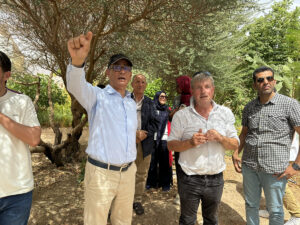Q&A: Åse Johannesson on Sweden’s potential to transform disaster risk reduction
A new policy report from Swedish Water House calls for an emphasis on integrating resilience-building into development, and expanding Disaster Risk Reduction (DRR) efforts beyond humanitarian aid.
The report “Water and Risk: Developing Sustainable and Resilient Communities” was produced by the Swedish Water House Cluster Group on DRR, led by SEI Research Fellow Åse Johannessen. The group has worked for three years to raise awareness of water issues within climate policy and DRR, aiming to inform Swedish policy and international cooperation. The group has emphasised resilience-building and preparedness. Water issues as part of DRR are highly relevant in the context of the UN climate negotiations and the Sustainable Development Goals process. Below, Johannessen explains why Sweden is well positioned to lead on DRR, and key ways in which it could do so.
Q: What motivated this report, at this particular time?
A: We have been working together for three years, and now is a good time to make an impact, as our recommendations can feed into the Swedish position on the next global action plan for DRR – the Hyogo Framework for Action (2), which will be decided upon in 2015. Sweden has also launched a new platform for its international development cooperation, with DRR as very prominent priority, although the strategic direction and specifics still need to be defined.
Q: How big a role does Sweden play in disaster risk reduction?
A: Sweden plays a major role, as it is one of the most important donors to the main DRR institutions, the UN Office for Disaster Risk Reduction (UNISDR) and the Global Facility for Disaster Reduction and Recovery (GFDRR). But it has yet to leverage that position to determine where the money goes. To really influence the global debate, Sweden needs an informed and explicit DRR policy, based on consultation with Swedish and global experts and practitioners.
Q: You note that Sweden, like most countries, has focused its DRR efforts on humanitarian aid and building resilience after disasters occur. Why is that not enough, and how does DRR need to change?
A: Most disaster risks today are created not by natural hazards alone, but by unsafe development. This is especially true in rapidly urbanising places, where a lot of surfaces have been paved over, so the water cannot drain and creates flood risks which were not there before. We need a fundamental shift, towards proactive planning and investment, building resilience, and addressing the underlying causes of risk.
Q: How might such an approach work in practical terms? Can you provide an example?
A: Some actions are cheap and easy, but can make a big difference. For example, building parking lots with surfaces that infiltrate water, rather than impervious pavement, can reduce urban flooding and disease for the urban poor. Public-private partnerships are crucial for small and larger-scale implementation. DRR needs to be associated with this type of activities as well, and not just with risks that have already become severe. DRR also definitely needs to be mainstreamed into development programmes, and better linked with humanitarian efforts. The international community needs to get its act together and coordinate for impact, and focus less on smaller projects and short-term results.
Q: How would such a change affect the countries that benefit from Swedish development and DRR assistance? Would proactive measures come at the expense of post-disaster humanitarian aid?
A: No, we are not talking about moving around resources from humanitarian aid, but rather understanding where disasters really originate. Let’s just take the example of the floods in Pakistan in 2010. Sweden provided much-needed humanitarian aid, but afterwards there could have been much more reflection about the underlying causes of this disaster and how to build capacity so these things will not happen again. We need to start to learn from past events and connect the dots, and to realise how poorly planned development can build up risks over time. If we don’t start now, the costs for emergency response will be even higher in the future.
Q: Your report focuses on Sweden’s foreign policy, but you also write about domestic implications. How might Sweden benefit from a more proactive, integrated approach to DRR at home?
A: Sweden does not have many catastrophic floods or droughts, but the lack of coordination and integration between flood and water quality management is a concern, especially with socio-economic and environmental implications. We also have very outdated legislation on water flows, which results in many uncoordinated activities in a river basin. We would really need planning of water flows at that level, which is one step above where planning is currently initiated (at the municipal level). The EU policy on floods is being implemented in Sweden, but this is work in progress. The willingness is there, but concrete steps of how to go about it is still to be seen.









